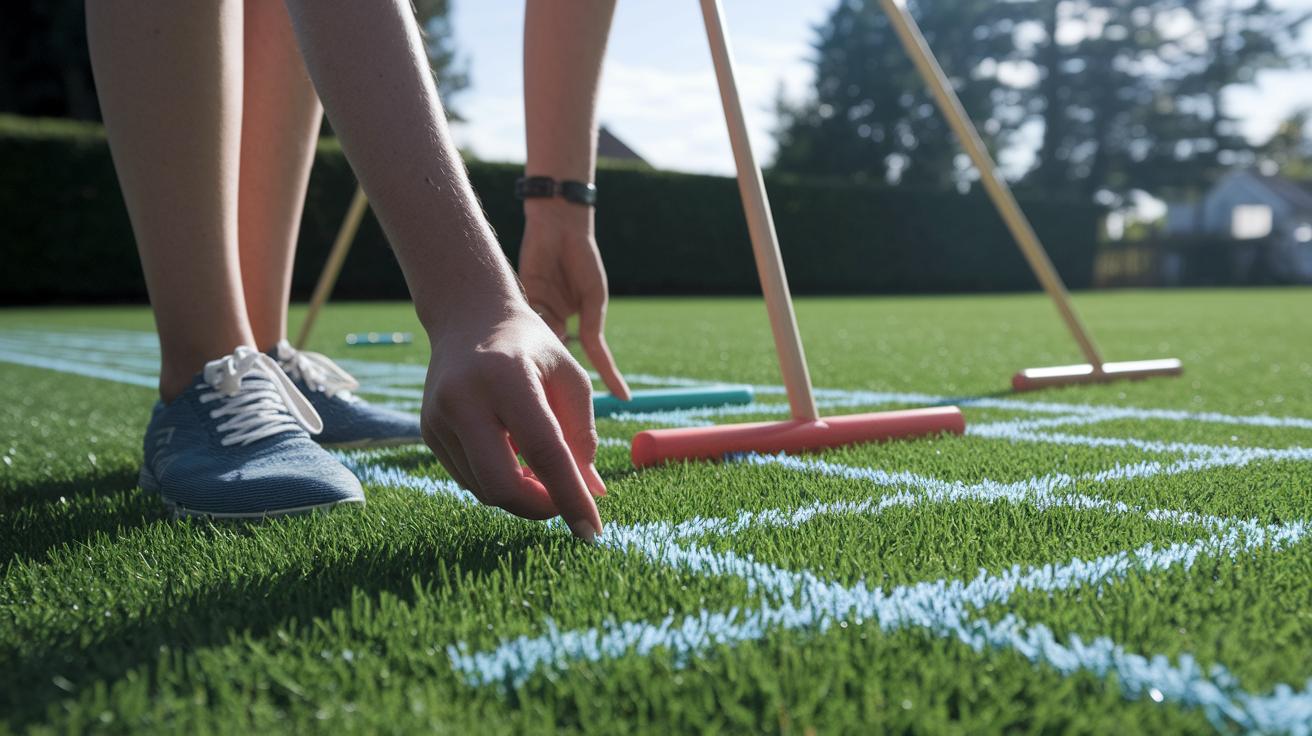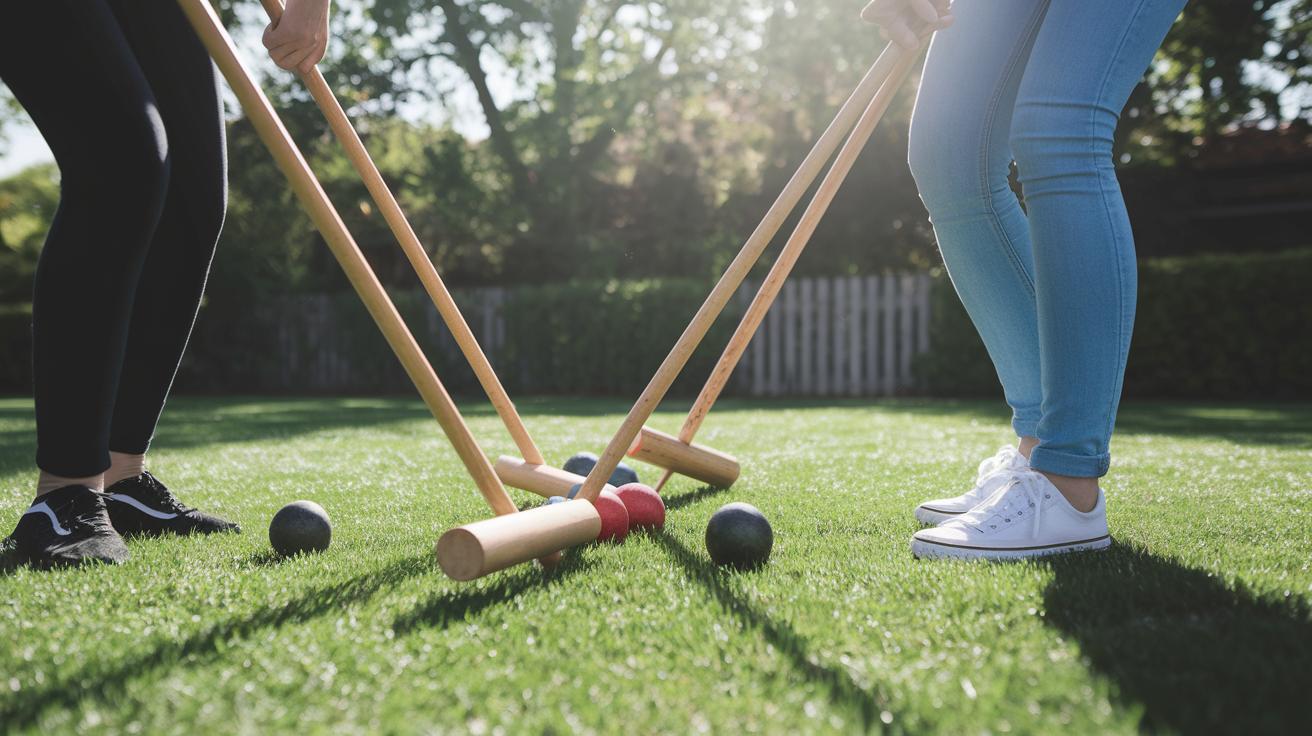Beginner Croquet Rules And Setup Made Effortless
Ever thought croquet was just a stuffy lawn event for fancy picnics? I used to think that, too. But it’s one of the easiest yard games to learn! Imagine warm grass under your feet and that thunk of your mallet (the stick you swing) hitting the ball.
In this chat you’ll find simple rules and a quick setup. We’ll talk about picking color-coded balls, marking a 20 by 15 yard court (that’s just your play area), and placing six wickets (those metal hoops). Then we’ll figure out who goes first and how to keep score. Oops, almost forgot. I’ll share tips for smooth turns.
Get ready to swing under warm sun, laugh with friends, and rack up points. You’ll feel like a backyard champion in no time. Let’s get that lawn game rolling!
Beginner Croquet Setup and Rules Overview
Hey neighbor! Ready to dive into croquet with the sun warming the grass under your feet? This quick guide helps you set up your game in no time.
Here’s the simple plan:
- Gather your mallets (wooden hammers used to strike the balls), croquet balls (hard balls you send through hoops), and six wickets (metal hoops pushed into the grass). See Section 2 for gear details.
- Mark a 20 by 15 yard rectangle on your lawn (yards are about three big steps). See Section 3 for the full court map.
- Push the wickets into a double-diamond pattern, two rows of three, one inside the other. See Section 3 for perfect spacing.
- Draw balls to pick who goes first, it’s like drawing names from a hat. See Section 4 for turn order rules.
- Then play! Swing your mallet, pass your ball through the hoops, score points, and roquet (tap another player’s ball to earn extra shots). Check Sections 4 and 5 for all the rules.
Let the game begin!
Croquet Equipment Selection for Beginners

Imagine warm grass under your feet and the soft hum of summer afternoon. Picking the right gear means smoother swings and fewer surprises on the lawn. You’ll need a mallet, balls, wickets (steel hoops), and a peg or stakes (rods marking your court). Ready to dive in?
Mallet Selection
Your mallet (long stick with a weighted head to tap the ball) comes in wood or composite materials. Aim for a head weight around 3 to 4 pounds. That extra heft gives you a satisfying thunk as the ball rolls through the wickets. But if you’re after a quicker swing, go lighter. Handles run 30 to 36 inches long. Stand tall, give each a swing, and pick what feels like part of your arm. By the way, make sure the grip feels right, my hands slip on super-smooth handles.
Ball Choice
Croquet balls (3.75 inch plastic or resin spheres) arrive in four bright colors so every player spots their own. A firm ball stays straight across the grass. A softer one slows down sooner, perfect if you like a more relaxed game. Which pace feels right for your afternoon match? Have you ever watched one curve through a wicket? Pure joy.
Wickets and Stakes
Wickets (steel hoops) stand about 3.25 inches tall with a 7 inch gap for your ball to slip through. Push them straight down so they stand firm when you miss a cheeky shot. For your center peg or boundary stake (wood or metal rod marking limits), choose 12 to 14 inches tall. They’ll peek above the grass so you never lose sight of your target. Planting these markers sets the stage for your best game yet.
Croquet Court Dimensions and Wicket Placement
Have you ever wanted your own backyard croquet court? It’s simpler than it sounds. A full-play court is 35 yards long and 28 yards wide, but if you’re just starting, a 20×15-yard patch works beautifully. Grab a tape measure or stretch a long rope. Feel the cool grass under your feet as you mark each corner.
Oops, I once tangled my rope, messy, but memorable.
Next, set up six wickets (metal hoops stuck in the grass for your ball to pass through). We use a double-diamond pattern: three wickets up front, three in back. Space them about 8 yards apart along the long sides. Then mark the center peg (a small stake you try to hit last). That peg is your final target and feels extra satisfying when you nail it.
| Element | Dimensions | Placement |
|---|---|---|
| Regulation Court | 35×28 yards | Full-size layout |
| Beginner Court | 20×15 yards | Smaller playing area |
| Wickets | 3.25″ tall, 7″ gauge | Double-diamond, 6 hoops |
| Spacing | Approx. 8 yards | Between wickets |
Beginner Croquet Rules And Setup Made Effortless

Nothing fancy here – just fresh-cut grass and a set of hoops (those are metal arches you push your ball through). Lay the hoops in a neat rectangle on the lawn and set your balls nearby. Feel that gentle breeze? Perfect croquet weather.
To pick who goes first, shake your colored balls in a hat or bag (you know, mix them up well) and have each player grab one with eyes closed. The color you draw decides your playing order, like a mini lottery for backyard fun. And off you go.
On your turn, you get one swing of the mallet (that's the wooden hammer you use). Push your ball through a wicket (a small metal hoop) and you earn an extra swing. Tap another player’s ball (that move's called a roquet, or tapping another ball) and you snag two bonus swings. Have you ever felt your heart skip as your ball nudges another? First you roll up to it, then you swing again. Nice, right?
Play moves clockwise around the lawn. Watch out for faults. A double tap (hitting your ball twice in one go) ends your turn instantly. Let your ball drift past the boundary line? It's out of bounds, and you drop it right where it crossed before your next turn. Keep each strike clean so everyone’s still smiling.
Now grab your mallet and get swinging – croquet's ready for you.
Croquet Scoring and Winning Conditions
Have you ever felt your mallet tap the soft grass as you line up for that little metal hoop? In croquet you score a point whenever your ball rolls right through one of those hoops (called a wicket). There are six wickets in the double-diamond layout, so a full pass nets you six points. Then comes the center peg. Give your ball a gentle knock against that peg to “peg out” (hit the end post) and grab one extra point. That final point feels like a mini celebration for your last shot. So one game can bring you up to seven points. The very first person to clear all six wickets and then peg out wins. Watching your score climb keeps every swing full of excitement, right?
Keeping track of points is super simple. Just draw a grid on a scrap of paper. List each player down the left side. Label the top with Wicket 1, Wicket 2, up through Wicket 6, and Peg. Every time someone rolls through a wicket or pegs out, mark a check. Want to make scorekeeping playful? Grab colored pencils or tiny stickers. When all the squares are filled, the player with the most checks takes the win, and earns serious backyard bragging rights!
Quick Croquet Setup Tips and Lawn Maintenance

First, mow your lawn to about ¾ inch. That low cut helps your balls roll smooth without wobbling. Then kick off your shoes and walk the court barefoot to feel any little bumps or dips. Flatten those spots with an old board or garden rake. Use a chalk line to draw crisp boundaries for your play area. And when you catch that fresh-cut grass smell drifting around, well, that’s your green light to start.
But once everyone’s taken their last turn, lift each wicket (steel hoop) straight up so the legs stay in place. Rinse your mallet heads and balls under a gentle spray to wash off stray bits of grass. Then set them in a sunny spot to dry. Oops, I learned that the hard way. Before you pack everything away, wipe the hoops with a dry cloth to chase away any moisture. Finally, stash your gear in the shed or garage, away from damp corners, so it’s ready for your next match.
Final Words
You’ve got your mallets, balls, and wickets ready with a clear 20×15-yard court plan.
Next, you’ve picked the right gear and learned how to space those hoops.
You’ve seen turn steps, scoring tricks, and even picked up a quick setup and care hack.
Now, grab a friend, stake your ground, and feel the spring in each mallet swing with beginner croquet rules and setup, let every shot bring a new grin.
A few playful misses only make that winning run taste even sweeter. Enjoy!
FAQ
What equipment do I need to start croquet?
The equipment you need to start croquet includes mallets (3–4 pound head, 30–36 inch handle), four-color balls (3¾ inch diameter), six steel wickets (3.25 inch tall), and boundary stakes.
How do I set up a beginner croquet court?
Mark a 20-by-15-yard rectangle, place six wickets in a double-diamond pattern, then draw balls for turn order before play.
How do I choose the right mallet and balls?
Pick a mallet with a 3–4 pound head weight and a 30–36 inch handle, plus 3¾ inch diameter plastic or resin balls in four colors.
Where should I place wickets on a beginner court?
Place six hoops in a double-diamond pattern about 8 yards apart within a 20-by-15-yard layout.
How do turns and bonus strokes work in croquet?
Draw balls for order, take one stroke per turn, earn extra strokes for running a wicket, and get two bonus strokes after a roquet.
How is scoring and winning determined in croquet?
Earn one point per completed wicket, gain a final point for pegging out, and the first player to clear all six wickets and peg-out wins.
Any quick setup and lawn care tips for croquet?
Mow grass to a ¾-inch height, chalk lines on a 20-by-15-yard court, then remove wickets, dry gear, and store indoors after play.







